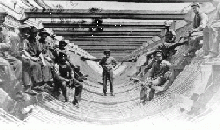The Mormon settlement of Utah was largely responsible for the modern introduction of small irrigation projects to the American West. Once the matter of water ownership was resolved, the federal government began the construction of immense dams and storage reservoirs. By the late 1880's, large-scale irrigation companies were operating throughout the western states and territories. The American example convinced William Pearce, Superintendent of Mines in the Northwest, that irrigation agriculture could open Canada's "desert lands" to settlement.
The first scientific expeditions in the 1850's were conducted by a man named John Palliser. He published the results of his exploration in 1857 and labelled the land that is now Southern Sasketchewan and Southern Alberta as semi-arid and, thus, an uninhabitable desert. The land he surveyed has come to be known as Palliser's Triangle.
After a length struggle, William Pearce eventually convinced Ottawa, the CPR, and regional business interests that the American success could be repeated here.
